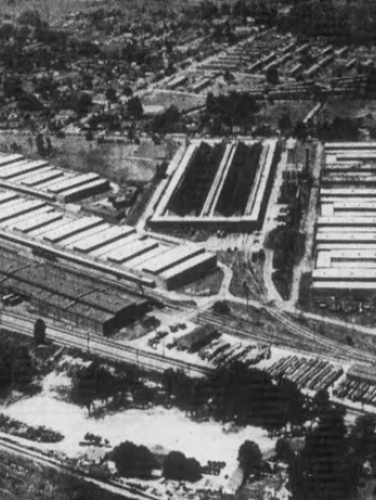
Charlotte Quartermaster Depot/Charlotte Area Missile Plant
(ca. 1941)
Once a Ford manufacturing plant, the Camp Road property later served as an Army quartermaster depot and manufacturing facility for guided missiles and military vehicles.
300 Camp Road, Charlotte, NC 28206
Originally one of twenty assembly plants built by the Ford Motor Company in the 1920s, the Camp Road property now comprising Camp North End sat empty for nearly ten years after its 1932 closure. In 1941, months before the U.S. was drawn into World War II, the U.S. government bought the nine-acre property, with its 200,000 square feet of workspace, for one of nine new quartermaster depots for the U.S. Army. Over the next few years, the Quartermaster Corps expanded the property to 72 acres, adding six warehouses and associated buildings totaling more than one million square feet of floor space to support the war effort.
Property Quick Links
Anticipating its inevitable involvement in WWII, the Army dedicated $3 million to building the Charlotte Quartermaster Depot to facilitate the efficient storage, sorting, and transportation of supplies to military bases. The old Ford factory property was ideal in part due to its proximity to existing railroad lines, allowing for the easy transport of goods. The new buildings required some eight million bricks and 150 brickmasons to meet the construction deadline. By September 1941, at least 1,300 people were engaged in building the warehouses. The project proved precient as the U.S. was thrust into the war by the December 7, 1941, bombing of Pearl Harbor during the Depot’s ongoing construction. Charlotte’s Quartermaster Depot serviced troops in Virginia and the Carolinas, providing uniforms, office supplies, tents, mosquito nets, toiletries, tools, food, and more. The Depot employed as many as 1,500 local, primarily male, civilians at any given time. But as American men went off to war, women began working many of the jobs previously reserved for men, including at the Charlotte Quartermaster Depot.
After WWII, while continuing its fulfillment role for military bases, the Charlotte Depot also became the military’s main classification, reclamation, and repair center east of the Mississippi River for military equipment returning from the war. In 1954, it was announced that the entire Charlotte Depot property would be turned into a production plant run by Douglas Aircraft for the Nike missile, the Army’s first guided anti-aircraft missile. The Army invested approximately $21 million to transform the 1.2 million square feet of floor space into a secure cutting-edge manufacturing facility for Douglas. Capable of holding atomic warheads, Nike missiles (including the improved “Hercules” model) were placed around nineteen cities across the country for added protection during the contentious Cold War. Concerned Charlotteans were assured that atomic warheads would not be present at the Charlotte plant. By 1959, the plant was Charlotte’s largest employer – with some 1,900 workers – but production was shut down in 1967 and the property was sold local developer E. Pat Hall.
Hall leased half of the space to Consolidated Diesel Electric Company to build Gama Goat trucks for the Army. A largely unsuccessful vehicle, the Gama Goat was a predecessor of the Hummer. The remaining space was leased to other private industries, most notably Brevoni Hosiery. When the Gama Goat plant closed in 1975, the property was purchased by Eckerd Drugs for a distribution center that operated until 2016 when the property was purchased for adaptive reuse as a commercial and residential complex known as Camp North End.

